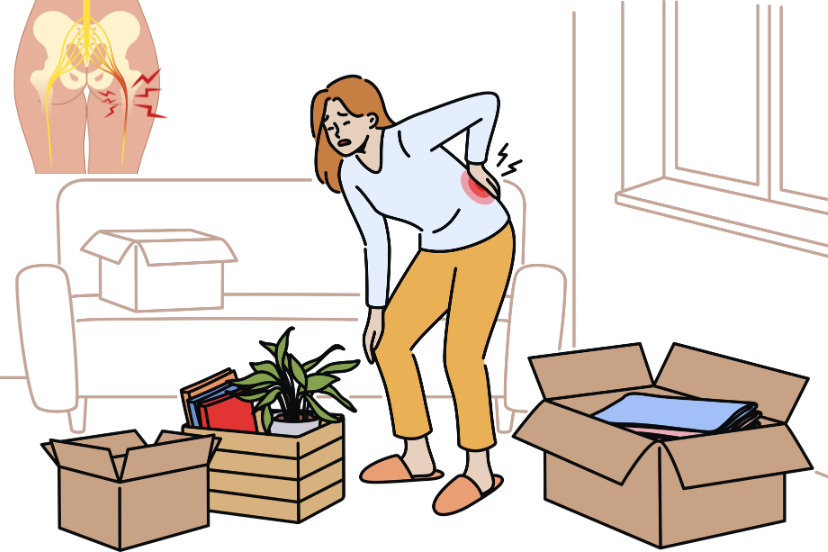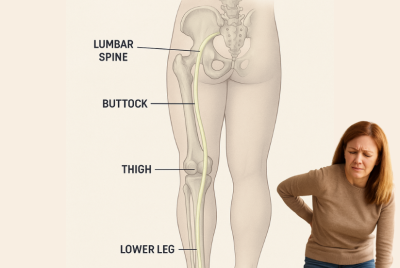Where Does Sciatica Pain Come From
Discover where sciatica pain comes from, its causes, symptoms, and effective tips for relief. Regain comfort with these expert insights! If you’ve ever experienced sciatica pain, you know it’s no ordinary discomfort. It’s sharp, radiating, and downright frustrating. As someone who’s dealt with it and guided others through their recovery, I’ll help you understand what causes this pesky pain and how you can tackle it effectively.
Understanding the Basics of Sciatica
Where Does Sciatica Actually Come From?
What is Sciatica?
Sciatica isn’t a condition itself but a symptom of an underlying issue. It’s the pain that shoots along the sciatic nerve, typically starting in your lower back and traveling through your hips, buttocks, and down your leg.
The Sciatic Nerve: Your Body’s Longest Nerve
The sciatic nerve is like the body’s superhighway, running from the lower spine to the feet. When it gets pinched or irritated, it sends out pain signals that can feel like electrical jolts.
Causes of Sciatica Pain
Herniated Disc: The Common Culprit
Imagine a jelly donut. When the “jelly” (disc material) leaks out and presses on your sciatic nerve, it triggers pain. This is the most common cause of sciatica.
Spinal Stenosis and Its Role in Sciatica
Spinal stenosis is a narrowing of the spinal canal that can squeeze the sciatic nerve, causing discomfort. Think of it as trying to squeeze through a tight doorway—you’re bound to feel pressure.
Piriformis Syndrome: A Lesser-Known Trigger
The piriformis muscle, located deep in the buttock, can spasm or tighten, irritating the sciatic nerve. While not as common, it’s a pain source worth considering.
Lifestyle Factors That Contribute to Sciatica
Sitting too much, poor posture, or even carrying extra weight can put pressure on the lower back and irritate the sciatic nerve.
Symptoms of Sciatica
Classic Signs of Sciatica
Sciatica pain usually strikes one side of the body, radiating from the lower back to the leg. It can feel like burning, tingling, or even numbness.
When Sciatica Pain Becomes Severe
Sciatica pain becomes severe when it includes symptoms like intense, persistent pain, weakness in the leg, difficulty moving, or loss of bladder/bowel control. If these signs occur, it’s important to seek immediate medical attention to prevent further complications and receive proper treatment.
How to Relieve Sciatica Pain Naturally
The Role of Stretching and Yoga
Stretching and yoga play a crucial role in relieving sciatica pain by improving flexibility, reducing muscle tension, and enhancing circulation. Specific stretches target the lower back, hips, and legs, helping to alleviate nerve compression. Yoga promotes overall body alignment, strengthens core muscles, and improves posture, all of which support spinal health. Incorporating these practices regularly can prevent future sciatica flare-ups and provide lasting relief.
Top Stretches for Sciatica Relief
Top stretches for sciatica relief include the piriformis stretch, seated spinal twist, and knee-to-chest stretch. These target the lower back, hips, and legs, helping to relieve pressure on the sciatic nerve, improve flexibility, and reduce muscle tension for better mobility.
Importance of Heat and Cold Therapy
Heat and cold therapy are effective treatments for sciatica pain. Cold packs help reduce inflammation and numb sharp pain, while heat therapy relaxes tight muscles and promotes blood flow, easing discomfort. Alternating between both can provide relief, with cold used for inflammation and heat for muscle tension. Using these therapies consistently can significantly reduce sciatica symptoms and improve mobility over time.
Incorporating Low-Impact Exercises
Medical Treatment Options for Sciatica
When to See a Doctor
You should see a doctor if sciatica pain persists for more than a few weeks, worsens despite home treatment, or is accompanied by severe symptoms like weakness, numbness, or loss of bladder/bowel control. Early intervention can prevent further complications and provide effective relief.
Medications for Sciatica Pain Relief
Medications for sciatica pain relief vary depending on the severity. Over-the-counter pain relievers like ibuprofen or acetaminophen can help manage mild pain. For more intense discomfort, muscle relaxants or nerve pain medications such as gabapentin may be prescribed. In severe cases, a doctor might recommend corticosteroid injections to reduce inflammation. Always consult with a healthcare provider before starting any medication for sciatica.
Surgical Options for Persistent Sciatica
Surgical options for persistent sciatica, typically considered after conservative treatments fail, include discectomy to remove a herniated disc or laminectomy to relieve spinal stenosis. Surgery is generally reserved for cases with severe, ongoing pain or when nerve damage is at risk.
Preventing Sciatica Pain from Coming Back
Improving Posture and Ergonomics
Improving posture and ergonomics is crucial for managing sciatica pain. Maintaining a neutral spine while sitting, standing, or sleeping helps reduce pressure on the sciatic nerve. Using ergonomic chairs, standing desks, and proper lifting techniques can prevent strain on your back. Simple adjustments like avoiding prolonged sitting or slouching can significantly reduce sciatica flare-ups and improve comfort during daily activities.
Strengthening Core and Back Muscles
Strengthening core and back muscles is essential for preventing and alleviating sciatica pain. Strong muscles support the spine, reducing pressure on the sciatic nerve. Exercises like planks, bridges, and back extensions improve posture, stability, and flexibility, which helps prevent future flare-ups. Incorporating core-strengthening routines into your fitness regimen ensures better spinal alignment and reduces the risk of injury, providing long-term relief.
Maintaining a Healthy Weight
FAQs Related to Where Does Sciatica Pain Come From
What does sciatica pain feel like?
Sciatica pain feels like a sharp, shooting sensation that radiates from the lower back down one leg. It may also cause tingling, burning, or numbness, making it uncomfortable to sit, stand, or move for extended periods.
Can sciatica go away on its own?
Yes, sciatica can often go away on its own, especially if it’s mild. With rest, proper care, and gentle exercises, symptoms typically improve within a few weeks. However, persistent or worsening pain may require professional medical attention.
How long does sciatica pain typically last?
Sciatica pain typically lasts a few days to weeks for mild cases. Acute sciatica may resolve in 4-6 weeks, while chronic cases can persist for months. Recovery depends on the cause, treatment approach, and overall lifestyle adjustments.
Does walking help sciatica?
Yes, walking can help sciatica by promoting circulation, reducing nerve irritation, and strengthening supporting muscles. However, it’s important to walk at a comfortable pace and avoid overexertion, as too much strain can worsen symptoms or lead to further discomfort.
Can stress cause or worsen sciatica?
While stress doesn’t directly cause sciatica, it can worsen symptoms by increasing muscle tension and inflammation. Stress may lead to poor posture, which can further irritate the sciatic nerve, making the pain more intense or prolonged.
What are some quick remedies for sciatica pain?
Quick remedies for sciatica pain include applying heat or cold packs, gentle stretching, and walking. Over-the-counter pain relievers like ibuprofen or acetaminophen can also help. Practicing good posture and avoiding prolonged sitting are essential for relief and preventing flare-ups.
Where Does Sciatica Pain Come From – Final Thoughts
Sciatica pain originates from irritation or compression of the sciatic nerve, often due to herniated discs, spinal stenosis, or lifestyle factors. Understanding its root causes is key to managing and preventing flare-ups. By incorporating stretches, low-impact exercises, and posture improvements, you can reduce pain and support long-term recovery. If symptoms persist, seeking medical advice ensures proper diagnosis and treatment. Sciatica doesn’t have to control your life—taking proactive steps can help you regain comfort and mobility. Remember, a balanced lifestyle with core-strengthening activities and healthy habits can keep sciatica pain from returning and improve your overall well-being.
Disclaimer
Please note that this article should not replace professional medical advice. Consult a healthcare professional for an accurate diagnosis and tailored treatment plan.






